Get PolitiFact in your inbox.
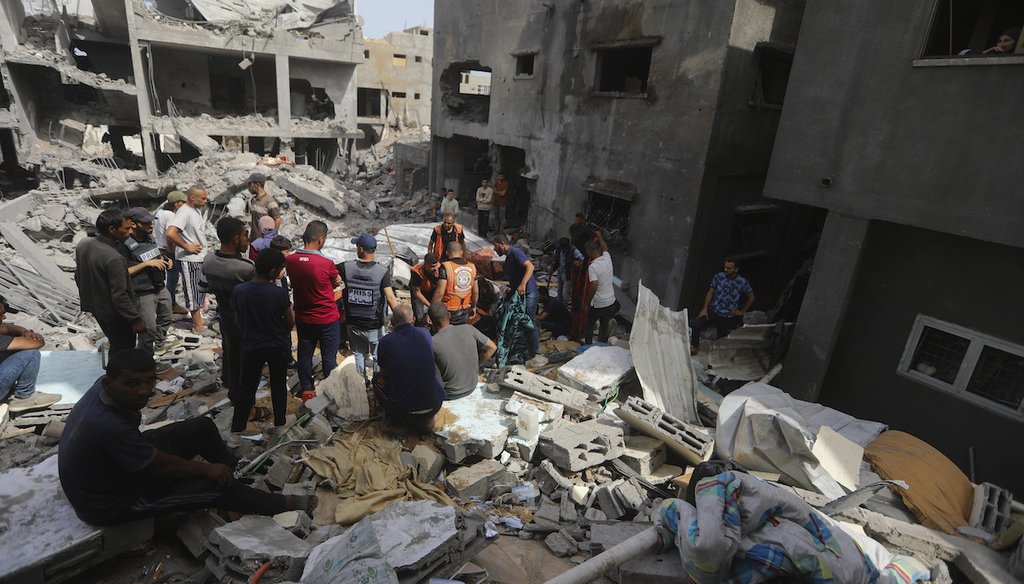
Palestinians look at the destruction after an Israeli strike on a residential building in Nuseirat Refugee Camp, Gaza Strip, May 19, 2024. (AP)
If Your Time is short
-
Starting May 8, the United Nations began sharing a demographic breakdown of the people who have died in Gaza who have been fully identified, according to the Ministry of Health in Gaza. Before that, the U.N. had shared data from the Government Media Office in Gaza that showed a greater number of women and children had died.
-
Hamas, the ruling authority in Gaza, controls the government entities that provide data on deaths in Gaza. These numbers cannot currently be independently verified.
-
Experts caution the available fatality data should neither be dismissed outright nor regarded as wholly reliable.
From the earliest days of the Israel-Hamas war, global leaders have questioned the reliability of fatality data coming out of Gaza. In October, without citing a specific reason, President Joe Biden said he had "no confidence" in the numbers.
Today, the overall figure of people dead is reported at about 35,000. But there’s no clear understanding about how many of these people are combatants and how many are civilians.
That’s because over most of the conflict, the figures have come from Gaza’s Ministry of Health, an agency of the region’s Hamas-controlled government.
Hamas, identified as a terrorist organization by the U.S. in 1997, has ruled Gaza since it swept a majority in 2006 parliamentary elections. After Hamas-led militants attacked Israel on Oct. 7, killing more than 1,200 people, Israel in its retaliation largely blocked foreign journalists from entering the Gaza strip. Israeli protesters blocked humanitarian aid. And Israeli attacks crushed Gaza’s infrastructure, fueling mounting concern about the Ministry of Health’s fatality data’s accuracy.
Without any other options, the United Nations and other leaders rely on Hamas government figures despite little transparency over its sources or methodology.
Sign up for PolitiFact texts
Its Ministry of Health describes all casualties as victims of "Israeli aggression."
Confusion over the figures reached a boiling point May 8, when the U.N. released data that showed a significant reduction in the number of women and children who had died Gaza:
On May 6, the U.N. had reported greater than 9,500 women and greater than 14,500 children dead. Two days later, the figures showed 4,959 women and 7,797 children.
"UN halves estimates of women and children killed in Gaza," MSNBC’s "Morning Joe" cohost Joe Scarborough wrote in a May 12 X post. Scarborough shared a May 11 Jerusalem Post article and said, "Apparently, the Hamas figures repeatedly cited are false."
Israeli officials also seized on the change: "The miraculous resurrection of the dead in Gaza," Israel’s Foreign Minister Israel Katz wrote in a May 13 X post. "The @UN had reduced its estimate of women and children killed in Gaza by 50% and claims that it relied on data from the Hamas Ministry of Health. Anyone who relies on fake data from a terrorist organization in order to promote blood libels against Israel is antisemitic and supports terrorism."
Another May 13 Instagram post said, "The UN quietly admitted the casualty numbers in Gaza were OVER INFLATED by nearly half."
Others said that critiques of the Ministry of Health’s fatality data went too far. Edward Ahmed Mitchell, deputy executive director for the Council on American-Islamic Relations, said that the reported death toll out of Gaza is likely an undercount of what he described as "mass slaughter."
Louis Charbonneau, the U.N. director at Human Rights Watch, said no one is going to have exact numbers, but the Ministry of Health data is the best available. "Death tolls are a messy business — extremely difficult," Charbonneau said. "And at the end of the day, no one is expecting 100% accuracy because it’s just impossible. We know the number’s big."
How much can the available data tell us? It’s complicated.
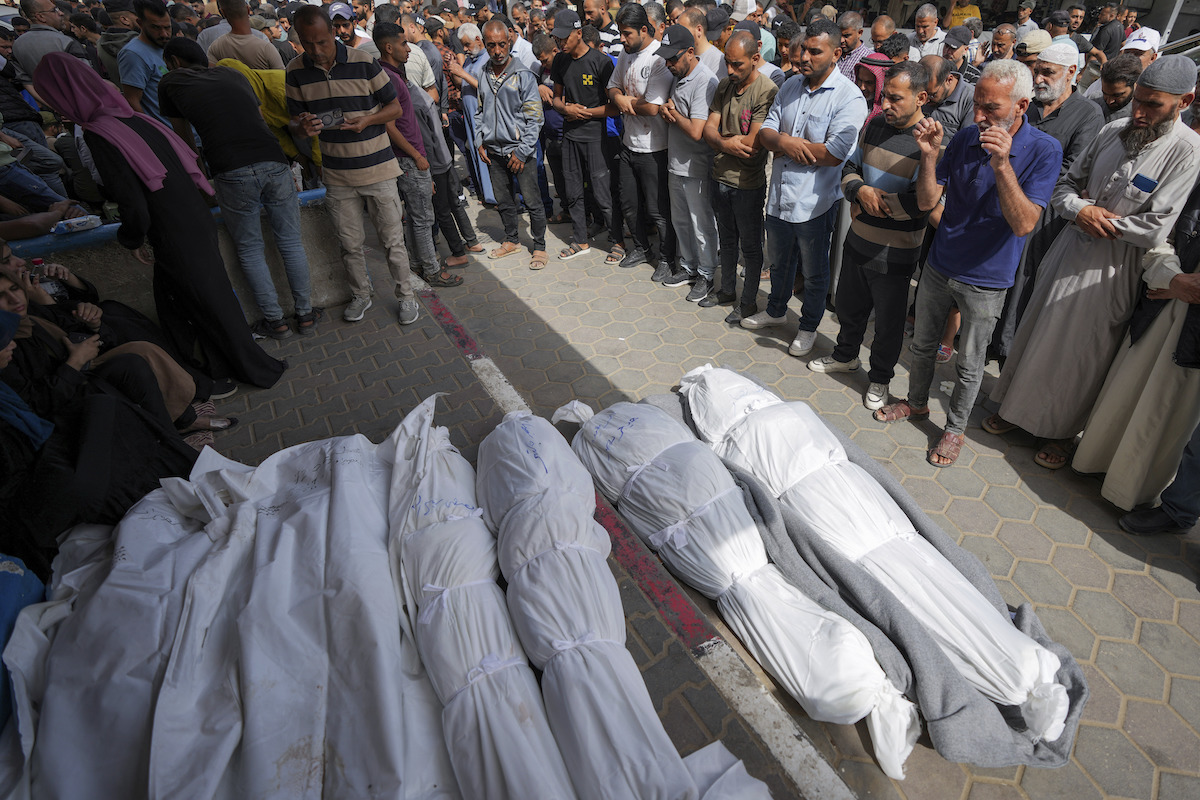
Mourners on May 19, 2024, pray over the bodies of Palestinians who were killed in an Israeli airstrike in Nuseirat, at the Al Aqsa hospital in Deir al Balah, Gaza Strip. (AP)
Did the fatality statistics get ‘halved’?
Not according to the U.N.’s explanation.
Farhan Haq, deputy spokesman for the United Nations Secretary-General, said the overall number of fatalities recorded by authorities in Gaza and reported by the U.N. have "remained unchanged at more than 35,000 people" since Oct. 7, 2023, when Hamas launched a violent attack on Israel. But the subcategorization on deaths of women and children changed because the ministry provided an updated breakdown of those whose identities it said had been fully documented. This was a smaller subset of the total number of fatalities.
Typically, when a conflict occurs, the U.N. gets its casualty data from what Haq described as "our trusted sources on the ground," then it cross-checks that information. The scale and intensity of the fighting in Gaza, however, sets this conflict apart and, in this case, Haq said, the U.N. has no means to verify firsthand the Ministry of Health’s data.
Although the data cannot be interpreted as incontrovertible, the U.N., World Health Organization and organizations that track conflict casualties said Hamas’ government-sourced data should not be dismissed outright.
Following previous conflicts, the U.N.’s efforts to independently verify the Ministry of Health’s fatality data found only small discrepancies. That said, this conflict stands apart in its scale of destruction, experts said, making the statistics’ reliability more of an open question.
Between the May 6 and May 8 updates, the total number of reported fatalities increased from 34,735 people to 34,844 people, including a subset of more than 10,000 people "reported missing or under the rubble."
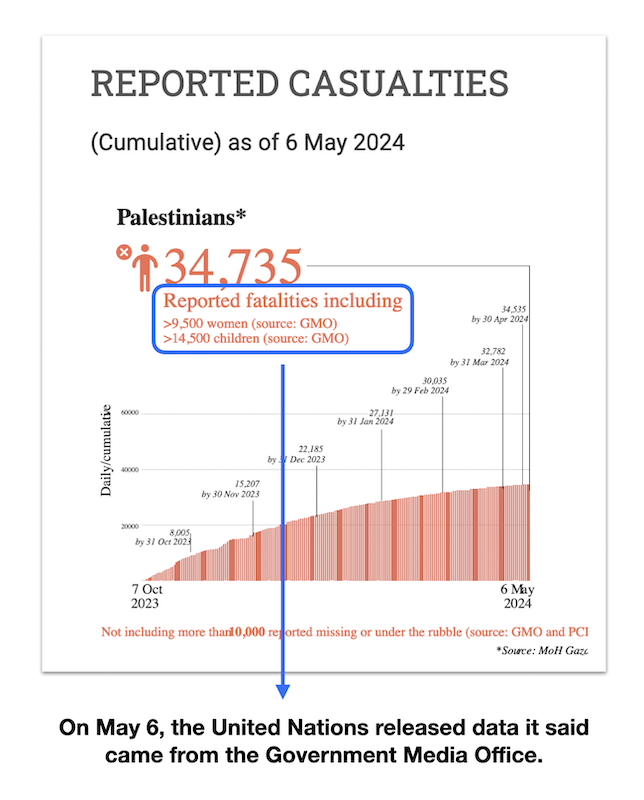
(Screenshot from the United Nations.)
The Government Media Office provided the May 6 estimate of reported fatalities, which included more than 9,500 women and more than 14,500 children. The U.N.’s May 8 graphic’s demographic breakdown is what sparked confusion and concern.
That graphic shows the Ministry of Health’s data for a smaller subset of the nearly 35,000 reported casualties, Haq said. It provides a breakdown of demographic information for 24,686 people the ministry had fully identified with their dates of birth and death, gender and ID number and whose deaths it had documented as of April 30, U.N. spokesperson Jens Laerke explained May 17.
During a May 13 briefing, Haq said the change came after the Ministry of Health provided an updated breakdown of fatalities "for whom full details have been documented."
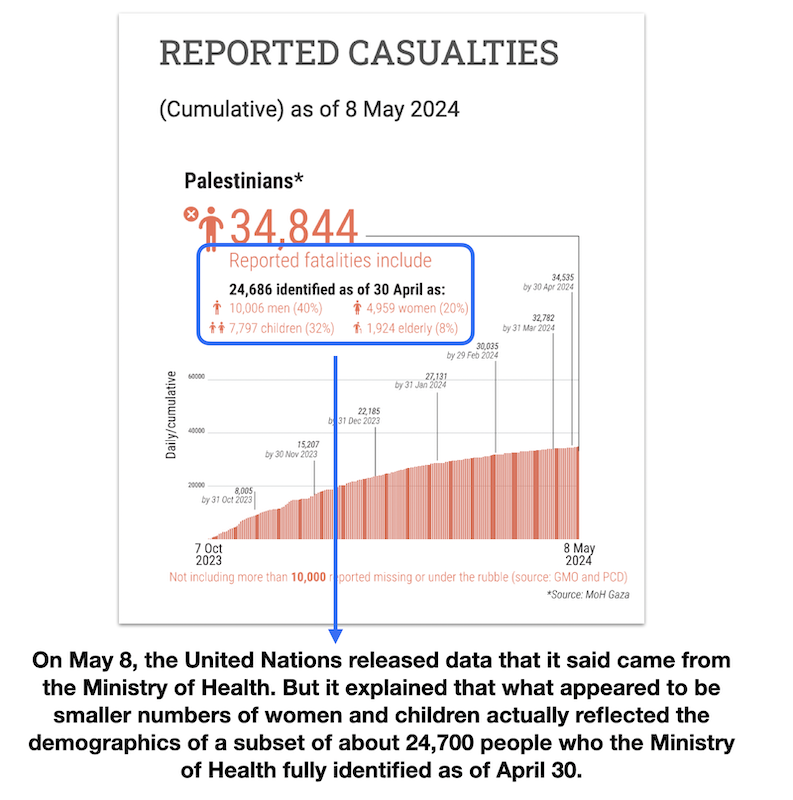
(Screenshot from the United Nations.)
"Out of those, then — out of that smaller number, that subset of identified bodies — you have 7,797 children, 4,959 women, 1,924 elderly and 10,006 men," Haq said during the briefing. People in the "elderly" group are not categorized by gender.
The Ministry of Health told the U.N. that it is still in the process of detailing the identities of all who are found dead, according to Haq.
We tried to contact the Government Media Office and Ministry of Health for additional information about the data but did not hear back.
How are deaths being recorded?
Early in the conflict, fatality data came from public and private hospitals, where medical workers recorded names, ages, genders and ID numbers of people who died. The information went into an electronic database, according to news reports.
Attacks on hospitals and communications blackouts significantly impacted the quality of data over time, researchers at organizations that track data about armed conflict told us.
On Dec. 11, 2023, the Ministry of Health announced in a statistical digest that it had started incorporating media sources for its fatality figures, said David Adesnik, a senior fellow and research director at the Foundation for Defense of Democracies, a conservative, foreign policy-focused think tank. The ministry did not identify what media sources it was relying on but the proportion of data coming from media accounts increased over time, Adesnik said: "Media sources served as the documentation for more than three-fourths of deaths counted during the first three months of 2024."
The biggest change in the U.N.’s data in early May wasn’t the data format, but its source, Adesnik said.
The May 6 update sourced its information on women and children killed to the Government Media Office; the May 8 update identified only the Ministry of Health.
During a May 17 press briefing, Laerke said that the U.N. views the Ministry of Health as the "best available source" for fatality data. Although the Government Media Office breakdown was used for a period when the ministry couldn’t provide data, the U.N. switched back to the ministry’s data when it became available again "because we provide the best available data at the time of reporting."
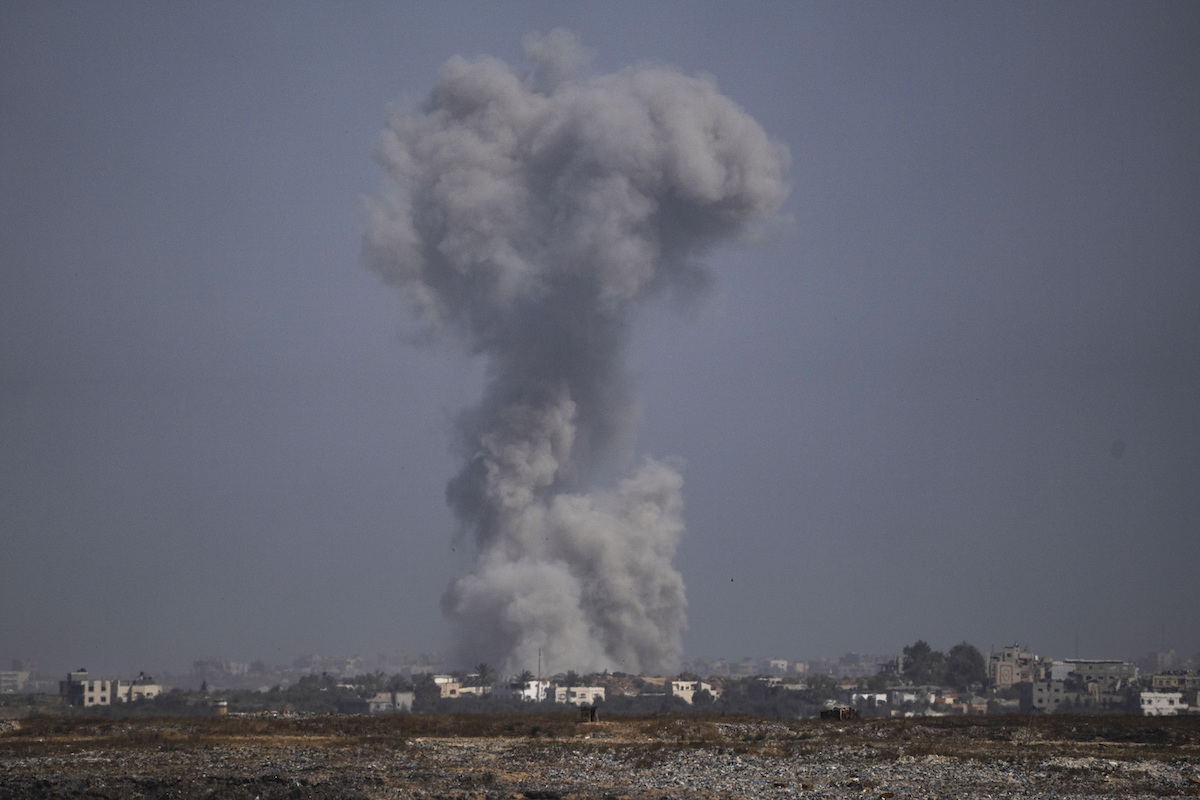
Smoke rises May 21, 2024, following an Israeli airstrike in the Gaza Strip, as seen from southern Israel. (AP)
What’s uncertain about the death toll in Gaza?
Salma Eissa, Middle East research manager for the Armed Conflict Location & Event Data Project, said data quality has diminished.
"There has been a discernible downward trend in the quality of the data, which has continued since mid-February when only three of the eight Gaza hospitals meant to track fatalities were doing so," Eissa said, citing April analysis by U.K.-based Action on Armed Violence, which records and investigates armed violence against civilians globally.
Rachel Taylor, the executive director at Every Casualty Counts, a U.K.-based organization that focuses on recording and identifying armed violence deaths, said that the current scale of devastation means the Ministry of Health’s data collection methodology "can no longer be applied consistently" as it has in the past.
"Over the course of the violence, the hospitals have been destroyed," said Taylor, who anticipates the actual numbers are higher than is being reported. "The morgues have been destroyed. The paper records have been destroyed. Healthcare professionals have been killed or displaced."
In the May 12 episode of the "Call Me Back" podcast, Israeli Prime Minister Benjamin Netanyahu said that about 14,000 combatants had been killed "and probably around 16,000 civilians have been killed." We contacted the Israeli Defense Forces for additional information about that data and received no response.
Experts at the Armed Conflict Location & Event Data Project cautioned that the Ministry of Health’s list of identified fatalities includes some deaths that might be attributable to Palestinian armed groups or have undetermined causes.
PolitiFact Researcher Caryn Baird contributed to this report.
Our Sources
Emailed statement from Farhan Haq, deputy spokesman for the United Nations Secretary-General, May 13, 2024
Interview with Rachel Taylor, executive director of Every Casualty Counts, May 15, 2024
Interview with Louis Charbonneau, UN director at Human Rights Watch, May 23, 2024
Email interview with Iain Overton, the executive director of Action on Armed Violence, May 16, 2024
Email interview with Clionadh Raleigh, president and CEO of the Armed Conflict Location & Event Data Project, May 16, 2024
Email interview with Salma Eissa, Middle East Research Manager at the Armed Conflict Location & Event Data Project, May 16, 2024
Email interview with David Adesnik, senior fellow and director of research at the Foundation for Defense of Democracies, May 16, 2024
Interview with Christian Lindemeier, spokesperson for the World Health Organization, May 17, 2024
Emailed statement from Edward Ahmed Mitchell, deputy executive director for the Council on American-Islamic Relations, May 22, 2024
Instagram post, May 13, 2024
Fox News, UN revises Gaza death toll, almost 50% less women and children killed than previously reported, May 13, 2024
Joe Scarborough’s post on X, May 12, 2024
United Nations’ YouTube channel, UNRWA, Syria, Haiti, & other topics - Daily Press Briefing (10 May 2024), May 10, 2024
Council on Foreign Relations, UN Halves Its Estimate of Women and Children Killed in Gaza, May 12, 2024
United Nations Office for the Coordination of Humanitarian Affairs, Hostilities in the Gaza Strip and Israel - reported impact | Day 213, May 6, 2024
United Nations Office for the Coordination of Humanitarian Affairs, Hostilities in the Gaza Strip and Israel - reported impact | Day 215, May 8, 2024
The Jerusalem Post, UN seemingly halves estimate of Gazan women, children killed, May 11, 2024
Israel’s Foreign Minister Israel Katz’s X post, May 13, 2024
Israel Foreign Ministry’s X post, May 12, 2024
Al Jazeera, Did the UN really say Israel has killed fewer people in Gaza? May 14, 2024
The Associated Press, What is Gaza’s Ministry of Health and how does it calculate the war’s death toll? Nov. 6, 2023
CNN, UN says total number of deaths in Gaza remains unchanged after controversy over revised data, May 14, 2024
The New York Times, U.N. Lowers Count of Women and Children Killed, Citing Incomplete Information, May 14, 2024
NBC News, U.N.’s new breakdown of Gaza death toll sparks confusion and anger, May 14, 2024
Time, The Science Is Clear. Over 30,000 People Have Died in Gaza, March 15, 2024
Time, What We Know About the Death Toll in Gaza, May 17, 2024
PBS NewsHour, WATCH: Biden casts doubt on Hamas-reported death toll, Oct. 25, 2023
The White House, Remarks of President Joe Biden — State of the Union Address As Prepared for Delivery, March 7, 2024
United Nations, Daily Press Briefing by the Office of the Spokesperson for the Secretary-General, May 13, 2024
Action on Armed Violence, Analysis of new death data from Gaza’s Health Ministry reveals several concerns, April 17, 2024
Action on Armed Violence, Quality data recording in Gaza, potentially evidencing genocide, frustrated by Israeli strikes – contravening International Court of Justice orders, Feb. 19, 2024
Action on Armed Violence, Evaluation of war-related deaths in Gaza: discrepancies and data quality decline after October 26 evident, March 21, 2024
Action on Armed Violence, Is the Hamas-run Ministry of Health data on fatalities in Gaza to be trusted? Nov. 1, 2023
NPR, Gaza's death toll now exceeds 30,000. Here's why it's an incomplete count, Feb. 29, 2024
Politico, A fixation on death tolls can be a fatal distraction, Dec. 6, 2023
United Nations TV, Geneva Press Briefing: OHCHR, UNHCR, OCHA, WHO, ITU, IOM, May 17, 2024
National Counterterrorism Center, Hamas overview, September 2022
Human Rights Watch, Gaza: Findings on October 17 al-Ahli Hospital Explosion, Nov. 26, 2023
Tal Hagin’s X thread, May 12, 2024
John Spencer’s X thread, May 4, 2024
PolitiFact, No, all Gaza schoolchildren have not been killed in Israel-Hamas war, Dec. 19, 2023
Foundation for Defense of Democracies, Gaza Health Ministry Cannot Provide Names for More Than 10,000 It Says Have Died, May 2, 2024
NPR, In Gaza, Palestinian journalists are documenting a war they're also trying to survive, March 15, 2024
The Washington Institute for Near East Policy, Gaza Fatality Data Has Become Completely Unreliable, March 26, 2024
CNN, Haunted by their colleagues’ deaths: The journalists risking their lives to report on Gaza, May 3, 2024
Reuters, Destruction, lawlessness and red tape hobble aid as Gazans go hungry, March 26, 2024
Vox, The controversy over Gaza’s death toll, explained, May 17, 2024
BBC, Gaza war: Why is the UN citing lower death toll for women and children? May 16, 2024
Vice, Israeli Intelligence Has Deemed Hamas-Run Health Ministry's Death Toll Figures Generally Accurate, Jan. 25, 2024


































